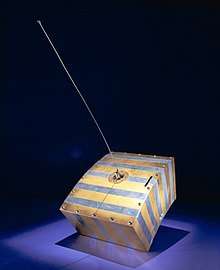Fox-1B
Fox-1B, AO-91 or AMSAT OSCAR 91[3] is an American amateur radio satellite. It is a 1U Cubesat, was built by the AMSAT-NA and carries a single-channel transponder for FM radio. The satellite has a whip antenna for the 70cm and 23cm bands (uplink), and a second antenna for the 2m band (downlink). Fox-1B is the second amateur radio satellite of the Fox series of AMSAT North America.
| Mission type | Communications |
|---|---|
| Operator | AMSAT[1] |
| COSPAR ID | 2017-073E[1] |
| SATCAT no. | 43017[1] |
| Spacecraft properties | |
| Manufacturer | Vanderbilt University, Radio Amateur Satellite Corporation |
| Launch mass | 1.3 kilograms (2.9 lb) |
| Dimensions | 10 by 10 by 10 centimetres (3.9 in × 3.9 in × 3.9 in) |
| Start of mission | |
| Launch date | 18 November 2017, 09:47 UTC |
| Rocket | Delta II 7929-10C |
| Launch site | Vandenberg SLC-2W |
| Orbital parameters | |
| Reference system | Geocentric |
| Regime | Low Earth |
| Semi-major axis | 7,013 kilometres (4,358 mi) |
| Perigee altitude | 461.3 kilometres (286.6 mi)[2] |
| Apogee altitude | 823.7 kilometres (511.8 mi)[2] |
| Inclination | 97.7°[2] |
| Period | 97.40 minutes[2] |
| Epoch | 24 June 2018[2] |
To facilitate a satellite launch as part of NASA's Educational Launch of Nanosatellites (ELaNa) program, the satellite carries a student experiment conducted by Vanderbilt University's Institute for Space and Defense Electronics. The RadFx experiment at this institute hosts four payloads for the study of radiation effects on commercially available electronic components. So it should be tested electronic components "off the shelf" under space conditions. The payload of AMSAT North America is a single-channel FM converter from UHF to VHF. After successful launch, the satellite was assigned the OSCAR number 91.
Mission
The satellite was launched on November 18, 2017, with a Delta II rocket, along with the main payload Joint Polar Satellite System and 4 other Cubesat satellites (MiRaTA, Buccaneer RMM, EagleSat and MakerSat 0) from Vandenberg Air Force Base. After only a few hours, telemetry was received and the transponder put into operation.
| Frequencies | |
|---|---|
| 145.960 MHz downlink | FM |
| 435.250 MHz uplink | 67.0 Hz CTCSS |
See also
References
- "AO-92". NSSDCA. NASA GSFC. Retrieved 2018-06-24.
- "FOX-1B (RADFXSAT AO-91)". n2yo.com. Retrieved 2018-06-24.
- "RadFxSat (Fox-1B) Launched, Designated AMSAT-OSCAR 91 (AO-91)". Trevor Essex. Retrieved 2018-06-24.
External links
- www.amsat.org (PDF)
